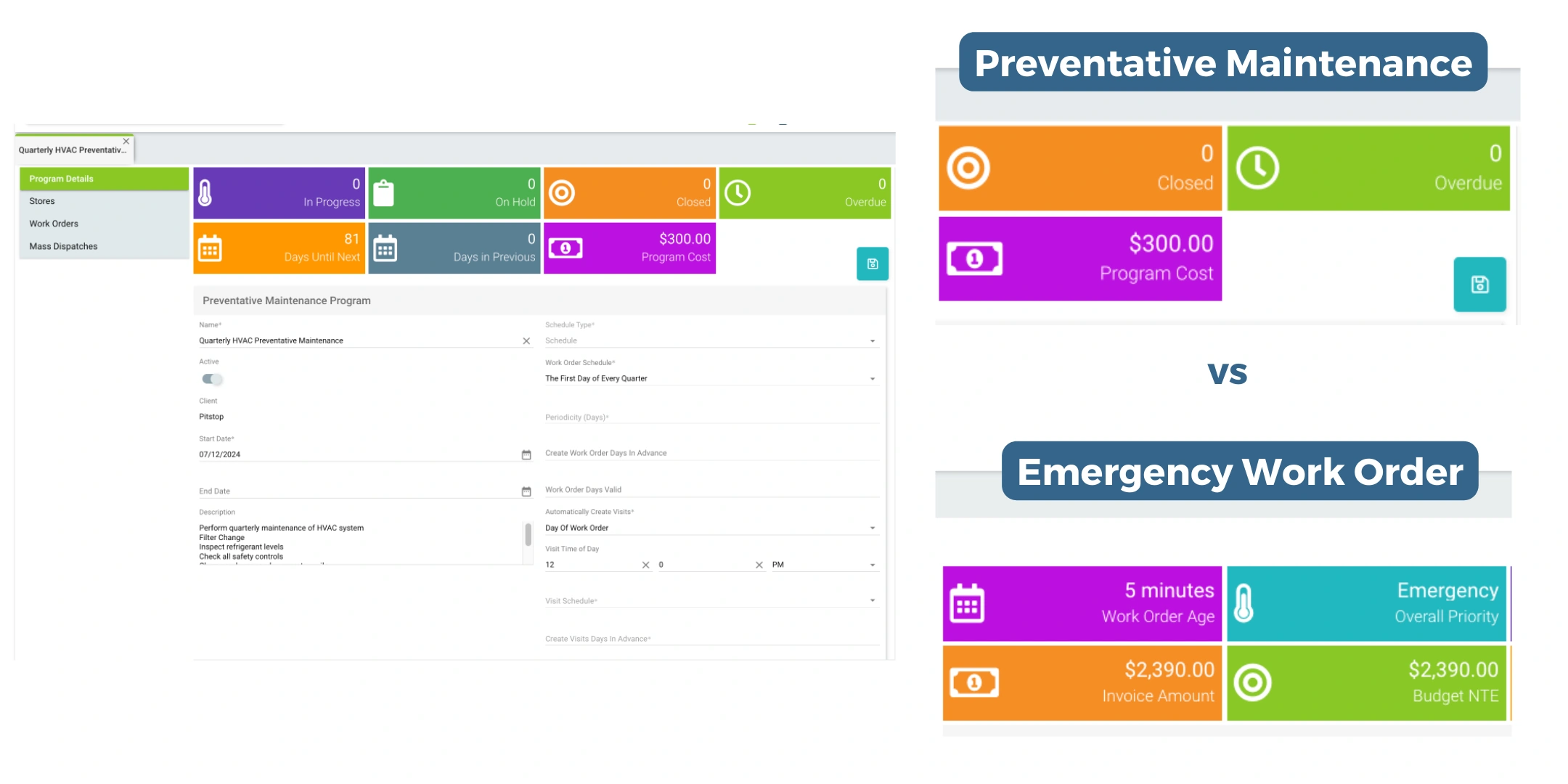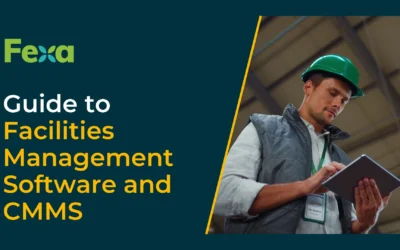ARTICLE
Six Ways Funky Facilities Management Workflows Hurt Your Margins
For retailers, restaurants, grocery stores, gyms, and other multi-location brands, a centralized facilities management approach is essential for maintaining a safe, successful and cost-effective environment. To truly maximize profitability, teams need to optimize the efficiency of their facilities management workflows. When done right, optimal facilities management workflows can also be an opportunity for growth and can create a competitive advantage for your business.
Without the right tools and strategies, however, inefficient facilities management workflows can be reactive and costly for businesses. Facilities teams – and the finance, operations, real estate and marketing teams they interface with – can easily lose control, leading to declining profit margins.
Time is money when it comes to centralized facilities management for multi-location brands. For example, according to a recent study, predictive maintenance can decrease costs by 10 to 40%. A predictive approach can also reduce downtime by up to 50%, and can extend the life of your machinery while lowering equipment costs and maximizing capital investments.
The Challenge: Messy Management Mutes Margins
Time is money. And when it comes to maximizing profitability for a multi-location business, a disorganized, tardy or reactive facilities management approach can do double damage, driving up costs while driving down foot traffic and sales revenue.
When this happens, a lack of adequate tooling to automate and optimize manual facilities management taskwork is ultimately to blame. These gaps can present a variety of challenges that make it difficult for even the best operators to maintain a competitive edge.
1. Overhead Costs
From managing work orders and vendor invoices, to asset management and landlord communications, as the volume and complexity of facilities management tasks surges, demand on internal teams also rises. Without the right processes and automation tools, facilities management teams can easily become overwhelmed, driving up overhead costs as worker bandwidth is exhausted.
Bandwidth issues can also limit team capacity for strategic reporting and decision-making, impacting overall department efficiency and effectiveness.
This excessive tactical workload not only hampers productivity but also leads to higher employee turnover, increasing recruiting costs and further diluting team efficacy as teams struggle to retain and replace skilled personnel.

2. Repair & Maintenance Costs
Inefficient facilities management can mean heavy repair and maintenance costs. A lack of efficient reporting and data hampers the ability to track and manage maintenance activities effectively.
As workflows slip, enforcing service level agreements (SLAs) with service providers becomes challenging, resulting in delays in addressing critical repairs. These delays can increase the scope of damage and drive up overall project costs.
Reactive repairs are notoriously more expensive, often costing three to four times more than proactive maintenance efforts. As a general guideline, teams should aim to allocate 50% or more of maintenance budgets for proactive vs reactive maintenance to maximize profitability. When preventative maintenance is neglected, facilities are more likely to encounter frequent and costly repairs, draining budgets and impacting the bottom line.
3. Capital Expenditures
When inefficient facilities management workflows lead to neglectful maintenance practices, critical asset expenditures can rise, eating into profit margins. Poor asset tracking reduces the regularity of preventative maintenance, resulting in more frequent and costly repairs and decreasing asset longevity.
Inadequate FM workflows can also inhibit the budget and bandwidth needed for modernization initiatives, such as LED retrofits, which can significantly cut energy costs and offer tax deduction opportunities.
4. Regulatory Risk Exposure
Inefficient tracking, maintenance, and repair of company facilities and assets increase regulatory risks and potential fines. Compliance with OSHA, EPA, LEED, and other sustainability regulations is critical to avoid significant penalties. Non-compliance not only invites fines, but also damages the organization’s reputation, potentially leading to lost business and decreased market trust. Maintaining up-to-date knowledge and implementation of regulatory requirements is essential for mitigating these risks.
5. Store Downtime
Inefficient facilities management can lead to extended store downtime, which directly impacts sales revenue. A slower response time to critical repair issues can hamper store operations and cause unexpected closures, which can negatively affect overall customer experience and profitability.
A great example of this are seasonal HVAC issues: Studies indicate that appropriately warmed or cooled environments can lead shoppers to spend 9–11% more, underscoring the importance of climate control in retail environments.
Inefficient facilities management workflows can also cause costly bottlenecks when opening new locations. Unforeseen issues with new buildings, unfamiliar landlords, and new service providers can complicate the process, leading to unforeseen delays. Efficient facilities management is crucial in navigating these challenges to ensure smooth and timely openings – and on-target sales revenues.
6. Poor Customer Experience
Inconsistent customer experiences between locations can deter customers from returning. Disorganized and poorly maintained stores can drive customers away, as 64% of surveyed shoppers have walked out due to disorganization and poor physical appearance. Research also finds 83% of customers would stop using a brand after just one bad experience, highlighting the importance of maintaining a consistent and high-quality customer experience.
The Solution: Improve Margins by Working Smarter, Not Harder
Curbing facilities management overhead costs can be achieved by embracing the automation benefits of a modern Computerized Maintenance Management System (CMMS) approach. By embracing the flexibility and automation features of an innovative vs legacy CMMS platform, facilities management teams can stay out of the weeds by eliminating manual taskwork and allowing for customized workflows that meet the specific needs of each location.
1. Automatically aggregate decision-making data
Make it easier for facilities management teams to make smart decisions and track reports maximizes their impact as drivers of business success. For example, gathering and reviewing vendor performance data for quarterly business reviews or general assessments provides valuable insights for informed decision-making.
Fexa enhances QBRs by offering customizable KPI weighting and accurate performance tracking through assignment-based workflows, ensuring precise and relevant vendor evaluations. This flexibility allows businesses to tailor assessments to their specific needs, leading to more effective vendor management and operational efficiency.
In this video, we show how Fexa’s reporting and analytics on things like vendor performance can help you make better business decisions.
2. Simplify Communications
Reduce manual communications and tedious taskwork helps facilities management teams work with joy and reduces turnover. For example, a platform with automated notifications and reminders can ensure that all stakeholders are informed on project status without the need for manual intervention.
3. Fix faster by auto-assigning vendors
Control repair and maintenance costs with a modern CMMS approach that makes it easier to manage a vast service provider network consistently. Centralizing the management of complex supplier networks allows teams to assign work orders to preferred vendors automatically, ensuring quality and reliability without slowing teams down or relying on more costly providers.
4. Avoid pass-through fees and surcharges
Avoid hidden costs and surcharges by choosing a CMMS that doesn’t impose participation, work-order, or invoicing fees. By working with such a CMMS, you can significantly cut costs and avoid the hidden pass-through fees that legacy platforms often charge service providers for network participation.
5. Automate routine maintenance to maximize OEE
Minimize unexpected capital expenditures and maximizing Overall Equipment Effectiveness (OEE) involves prioritizing preventative maintenance. Automation helps plan and schedule maintenance activities, ensuring all equipment and facilities are efficiently maintained.

Utilizing preventative maintenance and how it compares to an emergency work order
6. Tighten up on compliance to avoid fines
Complying with regulations and preventing costly fines requires working with a CMMS provider that considers the full range of legal, safety, and sustainability requirements faced by modern businesses. Keeping all stakeholders informed and leveraging features that support regulatory compliance helps avoid fines and ensures smooth operations.
7. Act faster to minimize downtime
Maximizing revenue by increasing the operability of every location in your ecosystem involves minimizing downtime and avoiding bottlenecks that delay new store openings. Using a CMMS with an extensive network of trusted vendors ensures urgent maintenance issues are promptly addressed.
8. Attract more, happy customers
Ultimately, attracting more customers and increasing visit times by creating consistently delightful in-store experiences can drive more sales volume. By automating workflows and leveraging advanced facilities management tools, organizations can improve efficiency, maintain high-quality customer experiences, and drive business success.
Get Out of A Funk With Fexa
Fexa can help you automate your facilities management tasks for a more efficient and strategic approach to FM. Learn more about how we equip organizations with the data they need to make better business decisions by visiting us at fexa.io today.
Say goodbye to the never-ending to-do list.
Blog
Related Articles
Stay ahead of the curve with our insightful articles, expert opinions, and innovative trends. We are committed to providing you with valuable information and industry insights to help you optimize and manage your facility more effectively.
Guide to Facilities Management Software and CMMS
FACILITIES MANAGEMENT / FEXA CMMSGuide to Facilities Management Software and CMMSHere's your ultimate guide to selecting the right facilities management software.Every time one of your facilities experiences a maintenance failure or equipment breakdown, it impacts...
The ROI of Refrigerant Management & Compliance Software: Is It Worth It?
ARTICLEThe ROI of Refrigerant Management & Compliance Software: Is It Worth It?Explore how refrigerant management software reduces costs, improves efficiency, and ensures compliance.Effective refrigerant management is no longer just a regulatory requirement—it’s a...
11 Signs It’s Time to Switch Your CMMS
ARTICLE11 Signs It’s Time to Switch Your CMMS Learn how upgrading to the right platform can streamline your operations and boost your bottomline.Your CMMS is supposed to make maintenance management easier, no matter how many facilities you are responsible for. But...





